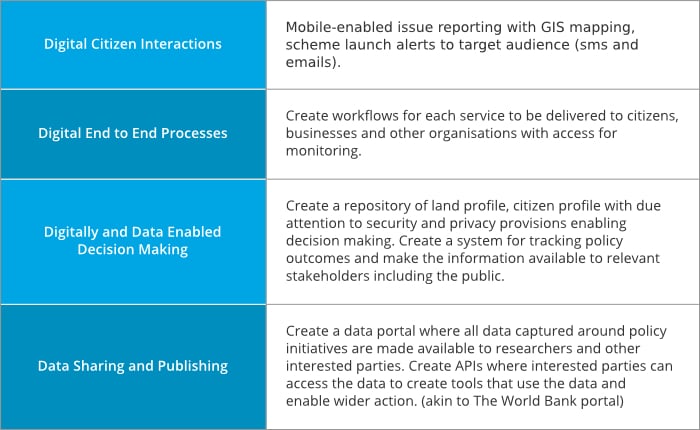Checklist for Developing a Point of View on E-Governance
The last decade has seen the quickening in the maturation of E-Governance across the world. This has been supported by rapid increase in internet accessibility, emergence of a number of applications for Government to Citizen, Government to Government and Government to Business services. This brief note works out the key values that should underlie an E-Governance initiative in a democratic government, a categorisation of digital initiatives - the key pillars - that constitute E-Governance and specific set of digital initiatives with in each category. This is only meant as a quick primer to think about building an E-Governance agenda and draws upon a selected work of McKinsey and Co in the area.
An E-Governance Framework
For a democratic government, its e-governance initiatives must stand the test of participative nature, inclusiveness, transparency, respect for citizen rights, efficiency and effectiveness. Therefore, these become the key values around which e-governance initiatives have to be conceptualized.
It is on top of these values that we look at the key pillars of web-enabled governance initiatives. Adopting a framework owned by McKinsey and Company, the key pillars of web-enabled governance initiatives are as below:
Digital Citizen Interactions
This includes a set of initiatives designed to disseminate information from the government to citizens as well as to gather information and feedback from citizens leveraging websites, social media, and mobile applications.
Digital End to End Processes
Here, government procedures and services workflow is managed using digital technology. This can enable efficiency, accountability, and transparency in service delivery.
Digitally and Data-Enabled Decisions
The technology advances in analytics can be exploited to improve decision making as well as improve transparency and accountability.
Data Sharing and Publishing
Government by virtue of its functioning gathers data of varied kinds. This data can support research into many key areas and contribute to improving the discourse in these domains.
The above has been summarised in the table as below.

With the above key premises, we have put together a set of initiatives that a government can undertake as part of their E-Governance agenda. These are not in any recommended sequence or priority.

Forwarding the agenda of democratic governance using the medium of digital has been made possible like never before with the advance in technology. A clear roadmap keeping in mind the reality of each polity and a commitment to the principles of democracy can help governments empower their citizens to lead fulfilling lives - especially in developing countries marked by resource scarcity.
Source: Karim Tadjeddine and Martin Lundqvist, “Policy in the data age; data enablement for common good”, McKinsey Insights, August, 2016 http://www.mckinsey.com/business-functions/digital-mckinsey/our-insight…, accessed October 2016.



